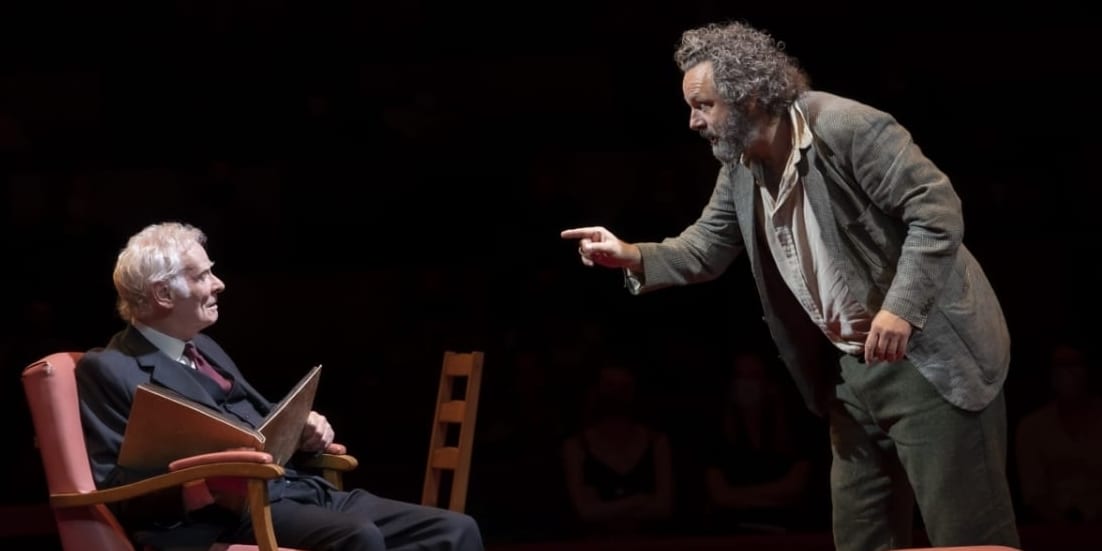This famous verse drama by Dylan Thomas was first produced as a radio play in 1954,
receiving many adaptations since then, as well as becoming a staple for study in schools. It
offers a portrait over a night and a day of a fictional Welsh fishing village and the thoughts,
hopes, fears and actions of around fifty characters within it. The focus on stream of
consciousness within a twenty-four-hour span is reminiscent of Joyce’s ‘Ulysses’, and the
plethora of lively, garrulous, contrasted characters harks back to the world of ‘The
Canterbury Tales.’ But it also is a document of twentieth-century Welsh society and culture,
which requires it to be set within that still familiar milieu. It is essentially an ensemble piece,
here taken up by fourteen actors, led by Michael Sheen, as the narrator, a role famously
first incarnated by Richard Burton.
Thomas described it as ‘a play for voices.’ It is written in a combination of lyric songs and
strongly accented free verse, which is already heavily freighted with remarkably sensuous
and sensual imagery designed to stimulate the imagination of the listener. Any stage
production needs to be judged by how much it adds to the sonic imagination by means of
movement and visual tableaus. According to that standard, this production achieves mixed
results.
At its heart lies a bravura performance by Sheen who shrugs off the shadow cast by Burton
in an animated embrace of the varied cadences of the role. In full command of the complex
text, he demonstrates a nuanced grip on the epic scale of his task, delivering moments of
rare delicacy alongside raw power. He is matched by the other performers, among whom
there are no weak links. It helps that most of the roles are played by older actors,
reimagining their younger selves. Not only does this ensure fine technique and a wealth of
experience, but there is suddenly an added poignancy to the themes of memory, ageing and
regret for missed opportunities or wrong turnings that lie at the heart of the work.
There is particularly fine work from Anthony O’Donnell as blind Captain Cat, Karl Johnson as
the Rev. Eli Jenkins, Susan Brown as the starchy Mrs Ogmore-Pritchard, and – above all –
from the 88-years-young Siân Phillips, who finds a warmth and a poignant undertow of lost
love in the role of Polly Garter that transcends age. Her lament near the end induces a still
frisson of silent intensity in the theatre that is the emotional highpoint of the evening. Given
the number of characters and shifts of scene, the sets and costumes by Merle Hensel are
more gestures than elaborate interventions; but that feels just right if momentum is to be maintained. There are some very neat, economical and effective physical improvisations, such as Nogoodboyo’s little rowboat suggested by a mere laundry basket.
So why only three stars?
The production labours under two major drawbacks. Firstly, the decision to repackage the
Olivier Theatre in-the-round wreaks havoc on the audibility and projection of the text: when
the actors face away from the main block of seats the lines are often indistinct and
inaudible. In a play where projection and interpretation of the text is the heart of the
matter, this is inexcusable. Secondly, the decision of the director, Lyndsey Turner, to frame
the play within a contemporary care home is of dubious worth. For the first twenty minutes
Siân Owen has provided a back story in which Sheen visits his confused father (Johnson) and
tries to restore his focus by using a photo album to trigger memories of their shared town,
from which the poem then emerges as the care-home residents slough off their modern
identities and inhabit the roles. As indicated, this does have the benefit of justifying the
decision to cast older and very able actors. But it is not clear that the device is worth all the
effort. If you believe in the original play, why not just find a new way of performing it as it is
rather than surrounding it with all this stylistically jarring prose padding?
For these reasons, the excellent work of the actors and creative team is muffled and
inhibited. It is like wrapping a building or statue about which you have unspecified doubts or
uneasiness.

